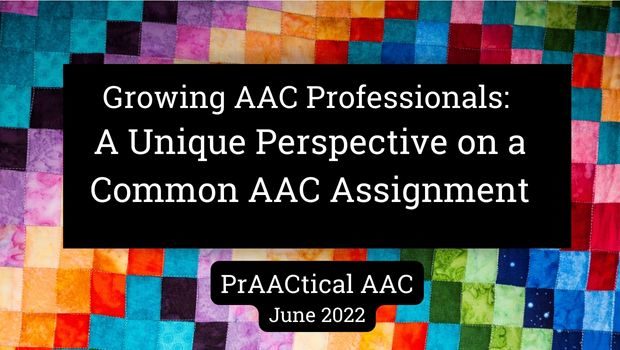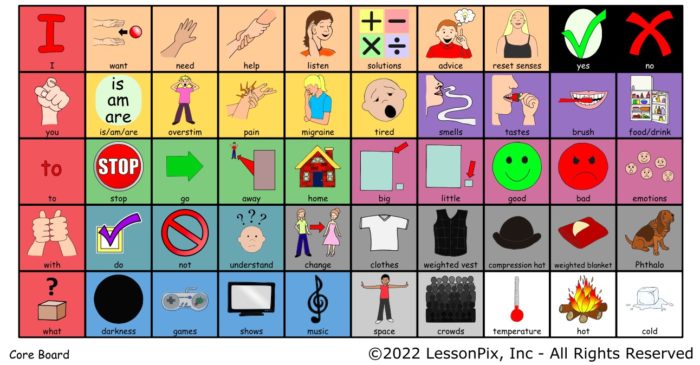Growing AAC Professionals: A Unique Perspective on a Common AAC Assignment

With our academic year behind us, we have the opportunity to hear and learn from those who teach AAC to future professionals. In today’s post, Vicki Haddix returns to share a student’s unique perspective on an AAC assignment.
Vicki is an AAC SLP and a Clinical Assistant Professor at the University of Memphis. You can read other posts by Vicki here. Watch for her interview with Rachel Madel on an upcoming episode of the Talking with Tech podcast.
:::::::::::::::::::::::::::::::::::::::::::::::::::::::::::::::::::
I’ve written in the past about some of my students’ final projects for the AAC class, but I wanted to specifically share something a little different this time. About halfway through the semester-long class, the students get an assignment requiring them to create a communication board to use themselves during a regular activity. This assignment comes after we’ve talked about the different ways to organize vocabulary and they’ve had a few chances to practice designing boards for hypothetical clients. My intention here is a bit about helping them understand what it’s like to use AAC and even more about how communication partners play a big role. But also a lot about the process of making your best guesses about necessary words and then realizing what also may have been helpful and why so you do better the next time.
Over the years, I’ve had students create boards to use to get coffee, order from favorite restaurants, have conversations with friends and family about a variety of topics, and even once attend a reptile show. When a student in the Spring 2022 class, Janine Peca, read the assignment directions, she had another thought. Here’s her explanation:
As an autistic person, sometimes I get overstimulated. When that happens, I can lose my access to speech and it becomes difficult to communicate my needs. This makes it hard for supporters in my life to help me change my sensory environment, so I can function again. As part of my AAC graduate coursework, I decided to create a personal overstimulation-based board. When I am overstimulated, it can become hard to see, so I kept that in mind while organizing the board. To this end, I went with more phrase-based locations and color-coding with less intense color sets.
Overall, the board is organized as follows: agents and function words are in red, motives in orange, internal dysregulation in yellow, locations in green, conditions in navy, visual sensory solutions in blue, spatial sensory solutions in light grey, temperature-based solutions in white, physical touch sensory solutions in dark grey, emotional response in maroon, oral/nasal sensation in purple, and yes/no responses in black. Overall, I picked a solutions-oriented theme for the board. Having completed this board, I would like to go back and create a companion problem-focused board to better identify noxious stimuli to my communication partner.
After Janine and I talked about this, we decided to share in the hopes that this board could be helpful to clinicians designing boards for their autistic clients. Janine has graciously put her board in the Sharing Center on LessonPix if you are one of their subscribers. Or you can simply take this as inspiration and use your preferred communication board builder.

Filed under: Featured Posts, PrAACtical Thinking
This post was written by Carole Zangari
